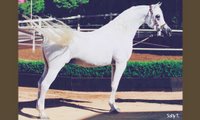 |
| Ansata Halim Shah |
I think this is my favorite photo, taken by Jerry Sparagowski, of Ansata Halim Shah (*Ansata Ibn Halima x Ansata Rosetta). What do you notice in this photo? For me, there is so much going on. It is immediately apparent that he was a most balanced horse. Ansata Halim Shah was a horse whose overall structure was one of uninterrupted smoothness. The outline or rather, the silhouette of Ansata Halim Shah was comprised of circular lines, creating an equality of body that is harmonious, elegant and graceful. There are no sharp angles, there are no abrupt interruptions to redirect lines that are gently flowing from one, into the next. He was not a horse of bits and pieces, rather, Ansata Halim Shah was a living sum of all his parts. Nothing was too short or too long; everything was perfectly suited for his body. For many, this horse is so special and for me personally, he is the standard, against which all horses are measured. Ansata Halim Shah will always be a timeless representative of classic Arabian Horse type. He continues to be relevant in the present day. If Nazeer was historically significant as a catalyst for modern Egyptian Arabian Horse breeding, then Ansata Halim Shah is critically significant for revolutionizing classic breed type, by underscoring the crucial need for balance.
In Lady Wentworth's AUTHENTIC ARABIAN HORSE, she speaks of balance:
"Many men worry more about measurements than type, and are lost without their inch tape and their measuring standard....An 'eye' for a horse is a gift like an ear for music. It is a sense of proportion and harmony and co-relation, the power to balance the points at a glance."
Judi Forbis, his breeder and his owner, described Ansata Halim Shah as
"one of those special horses from the day he was born. He was extreme of type, as one would expect of his unique linebreeding to the very classic Nazeer daughters, *Ansata Bint Mabrouka and *Ansata Bint Bukra, as well as being sired by the Nazeer son, *Ansata Ibn Halima. Halim Shah has always been an individual. He is smart, bold, and carries himself with elegance and grace."
And a majority of people seemed to have agreed with Judi, as Ansata Halim Shah was a 1983 United States Top Ten Futurity Colt and a 1983 World Reserve Junior Champion Stallion at the Salon Du Cheval, where he was spotted by Dr. Hans Joachim Nagel. Later, Ansata Halim Shah would travel to Germany, to Katharinenhof and dramatically influence Egyptian Arabian Horse breeding in Europe, and from there, all over the world. Dr. Nagel, in his Hanan book speaks about the Ansata influence:
"The most desired attributes of the Ansata stallion are a superbly laid-back shoulder, and ideal croup and the ability, so rarely found in Egyptian stallions, to sire stallions and mares of equal quality."
 |
| Thaqib Al Nasser |
Take for example a child, who has learned to color between the lines in his coloring book. His hands have filled the black-lined outline with a vibrancy of color that the lines cannot contain anymore. So, the color spills out, influencing other empty pages with equal vibrancy and fullness and yet, possessing a loyalty to the colors that one sees. Ansata Halim Shah is like that page in a child's coloring book. He remains relevant through his progeny and particularly through his sons who are hauntingly familiar. One cannot look at a horse like Al Adeed Al Shaqab or Thaqib Al Nasser and miss the unmistakeable Ansata Halim Shah look. Again from Lady Wentworth's work:
"It is always," Said Gayot, "the best shaped horse that is most consistently successful; a good sire is almost always beautiful."
Enjoy your horses,
Ralph


feel the same way about Ansata Halim Shah; the last photo in the post i have not seen before, nice! thank-you for all of your posts -
ReplyDelete